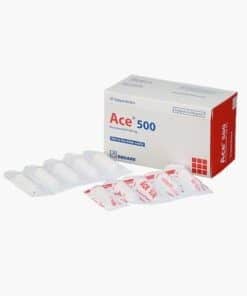Trupan | 20 mg | Tablet | 10 pcs
৳ 70.00
Brand Name: Trupan Tablet (Enteric Coated)
Generic: Pantoprazole Sodium Sesquihydrate
20 mg
Manufacturer: Square Pharmaceuticals Ltd.
Unit Price: ৳ 7.00 (6 x 10: ৳ 420.00)
Strip Price: ৳ 70.00
Indications
Pharmacology
Dosage & Administration
Adults: 2 mg once daily with or without food, at any time of the day. Due to the specific mode of action of prucalopride (stimulation of propulsive motility), exceeding the daily dose of 2 mg is not expected to increase efficacy.
Older people: Start with 1 mg once daily; if needed the dose can be increased to 2 mg once daily.
Children: Prucalopride should not be used in children and adolescents younger than 18 years
Interaction
In-vitro data indicate that, Prucalopride has a low interaction potential and therapeutic concentrations of Prucalopride are not expected to affect the CYP-mediated metabolism of co medicated medicinal products. Although Prucalopride may be a weak substrate for P-glycoprotein (P-gp), it is not an inhibitor of P-gp at clinically relevant concentrations.
Ketoconazole (200 mg b.i.d.), a potent inhibitor of CYP3A4 and of P-gp, increased the systemic exposure to prucalopride by approximately 40%. This effect is too small to be clinically relevant. Interactions of similar magnitude may be expected with other potent inhibitors of P-gp such as verapamil, cyclosporine A and quinidine.
Studies in healthy subjects showed that, there were no clinically relevant effects of Prucalopride on the pharmacokinetics of warfarin, digoxin, alcohol, paroxetine or oral contraceptives.
Contraindications
Side Effects
Pregnancy & Lactation
Precautions & Warnings
- Renal excretion is the main route of elimination of prucalopride. A dose of 1 mg is recommended in subjects with severe renal impairment.
- Caution should be exercised when prescribing Prucalopride to patients with severe hepatic impairment (Child-Pugh class C) due to limited data in patients with severe hepatic impairment.
- In case of severe diarrhoea, the efficacy of oral contraceptives may be reduced and the use of an additional contraceptive method is recommended to prevent possible failure of oral contraception.
- The tablets contain lactose. Patients with rare hereditary problems of galactose intolerance, the Lapp lactase deficiency or glucose-galactose malabsorption should not take this medicinal product.
Use in Special Populations
Renal Impairment: The dose for patients with severe renal impairment (GFR <30 ml/min/1.73 m2) is 1 mg once daily. No dose adjustment is required for patients with mild to moderate renal impairment.
Hepatic Impairment: Patients with severe hepatic impairment (Child-Pugh class C) start with 1 mg once daily which may be increased to 2 mg if required to improve efficacy and if the 1 mg dose is well tolerated. No dose adjustment is required for patients with mild to moderate hepatic impairment.
Overdose Effects
Therapeutic Class
Storage Conditions
| Generic Name | Pantoprazole Sodium Sesquihydrate |
|---|---|
| Tablet | 20 mg |
Only logged in customers who have purchased this product may leave a review.













Reviews
There are no reviews yet.